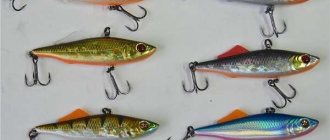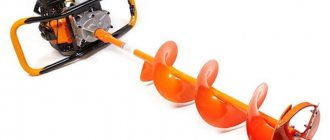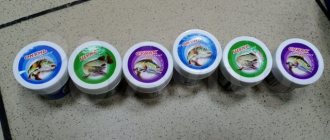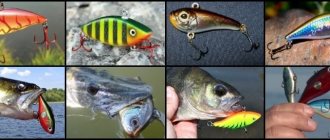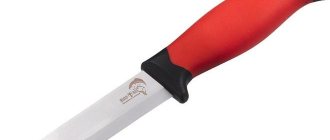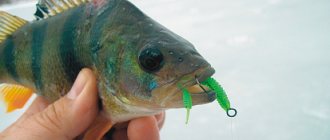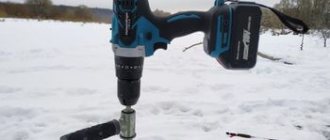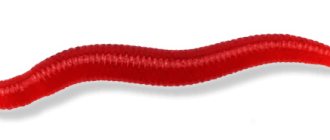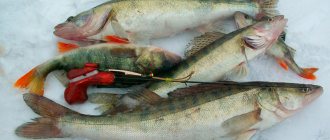Fishing for rattlins (ratlins, rattlings, vibes, English - rattlin, lipless crankbait, colloquial - rattlers) is a fascinating process that will not leave any fishing lover indifferent in the winter season. In the cold season, it is rattlins that are most often used to catch trophy specimens of predatory fish. When going to a pond, you should take with you not only suitable gear, but also the most catchy winter bait - rattlin.
Ratlin for winter is a good bait for catching pike, pike-perch and perch.
Rattlin: what is it and what do they eat it with...predators
Rattlins are bladeless, flat, sinking wobblers. In appearance, artificial bait resembles a small fish, the narrow body of which is flattened on the sides, and the wide head is slightly beveled. Manufacturers make wobblers from plastic and silicone. Most models are equipped with metal balls, which create a noise effect when wired.
Rattlin's game is high-frequency. You can secure the line using a loop located on the back of the bait. During wiring, the vib begins to create small oscillatory movements in the water, attracting the attention of predatory fish.
From the author. Ratlin is a bait for intellectuals; without having his own game, he reacts only to the actions of the fisherman. Therefore, the ability to correctly select and present a vibe for different fish in different conditions is the basis of success. So, let’s say pike perch prefers quiet Ratling models, and pike prefers noise ones. At shallow depths of up to 2-3 meters, rattlin shows good results in throws with a fairly large amplitude, and at depths of 5+, animations like high-frequency dribbling, as well as smooth stretches followed by a pause and release into free fall, perform well. And so on and so forth - study, understand and apply...
Difference from vibe - what is it?
Vibes are bladeless wobblers of the sinking type. They vibrate during play. Europeans call artificial fish differently:
- vertical wobbler;
- bladeless wobbler;
- Vibom.
Rattlin denotes a specific modification of bladeless wobblers, and vib is the name of a group of artificial baits of a similar design.
Ratlin Lucky John for winter and summer fishing - video review of new products for the 2020-2021 season:
Bait effectiveness
With proper understanding of their characteristics, rattlins are the most effective baits for catching winter predators. A bladeless wobbler creates low-frequency vibrations, which especially attract the attention of a predator.
It is especially effective to use in situations where you need to stir up a passive predator and lure does not produce results.
The shape of baits is almost always oblong to one degree or another, reminiscent in appearance of bleak and minnow. Artificial fish show excellent catchability not only in summer, but also in winter.
If there is a sluggish fish bite, then it is worth using small rattlins. A large bait is suitable for catching a trophy specimen.
Criterias of choice
When purchasing rattlin, it is important to pay attention to such parameters as the shape, size, weight and color of the artificial fish.
Form
Classic Rapala Ratlins have a flat diamond-shaped outline. During retrieval, the bait creates a vibration that attracts the attention of pike and pike perch. Models of products with purlined shapes resemble bleak and minnow in appearance. Winter wobblers are available for sale with an upper blade that imitates the upper fin of a fish. This feature allows for wider and smoother play.
It is worth noting that more powerful ratlings are suitable for catching pike perch, while pike prefers vibrations with a wide and massive body.
A large pike perch took 55 neutral buoyancy strategist
Size
The standard size of winter vibes is smaller than summer ones. In winter fishing, ratlins larger than 7-8 cm are rarely used when catching real trophies. For perch the standard is 4-5 cm, for pike perch 5-7, for pike up to 8 cm.
If bites are not observed in a pond for a long time, for example, in the middle of nowhere, it is advisable to use small-sized rattlins, the length of which is within 6-7 cm. Large-sized products will be needed for catching trophy specimens.
We recommend having in your arsenal the entire size range from 4 to 8 cm. This will allow you to be variable when fishing and not depend on the strength of the current, depth, type of predator and other conditions.
Weight
Light baits are very difficult to drive to depth. Such ratlings are ideal for fishing in shallow areas of the reservoir. To catch predators at significant depths during winter fishing from ice, it is worth using heavy rattlins, the weight of which reaches 15-20 grams or more. This is especially true when fishing for pike perch and large perch in holes in the area of reservoirs.
Buoyancy factor
One of the differences between ratlins, which are used for fishing in winter, and summer ones, is buoyancy. In winter, it is important to use sinking and slowly sinking models, for obvious reasons - the wiring is in the vertical component, in contrast to the horizontal one in summer.
With proper skill, you can also use suspenders, skillfully loading them with additional accessories, but this is an option for experienced fishermen who understand how to do this without losing the bait in the game.
Winter Ratlin almost always sinks to some degree
Noise effect - what is your acoustics to me, will a predator recognize in winter?
When fishing for pike perch in the cold season, you should avoid purchasing baits that contain metal balls; excess noise will only scare the predator away from the hole. But when fishing for perch and pike in winter, you need to experiment with noise effects. Because not everything is so simple.
Dew point, also known as attachment point
Depending on the attachment point, the Ratlin will have a different game. In one case it is more twitchy (with the flail closer to the nose of the bait), in another it is smoother and has a high amplitude - fixation in the center.
There are models that have several attachment points.
By the way, some prototypes of ratlins are cicadas, which spinning anglers use when catching perch, pike and pike perch, and more often in the summer. But in winter you can also successfully use this type of vibe in iron form.
Coloring makes your eyes run wild, but is this factor really that important?
In cases where you plan to fish at significant depths, it is better to give preference to light, natural-colored baits. In shallow water it is worth using brightly colored wobblers. At depths of 7+ meters, you should prefer acidic and fluorescent colors. It is precisely such provocateurs that are noticeable to a predator rubbing at the very bottom in deep holes and edges.
An acid man and a straight man - a couple that will close the entire deep opening
At dusk you should also give preference to light-colored baits.
Types of ratlins
Ratlins, also known as vibes, are a relatively new type of bait for domestic fishermen. In terms of their design features, they are bladeless wobblers, with a fastening on the back and a pair of hooks on the tail and on the abdomen. Its distinctive feature is a unique game during retrieving, which well imitates the movement of real fish. They are intended for catching predatory fish, both in open water and from ice. Today there are many varieties of vibrations, differing in technical parameters:
Each type of vib, depending on its technical characteristics, performs best when fishing at a certain time of the year, and for a specific type of aquatic predator.
Features of pike perch baits
For pike perch in winter, ratlins of a purlined, elongated and laterally flat shape are used. Since pike perch itself is a fairly large fish, the most suitable bait length for ice fishing is 60-90 mm . Since in winter the fish tries to hide in holes, fishing is carried out at great depths. Near the coast it can be found at the beginning of winter, on the first ice. In the dead of winter, pike perch goes to deep areas of the bottom, where more oxygen is retained and the water is warmer than in the surface layers.
This feature of the behavior of pike perch determines the use of heavy, quickly sinking vibes weighing from 10 to 20 grams . For depths exceeding 15-20 meters, it is recommended to use more massive baits, weighing up to 30 g. On the first ice, when fish are still caught in coastal shallow waters, you can use silicone vibes with a low mass. But in general, such slowly sinking models are intended for summer fishing with horizontal fishing.
Why not a spinner or a balancer?
Recently, many ice fishing enthusiasts prefer rattlins over a traditional spoon or balancer. This is due to the greater effectiveness of vibrations during the deep winter period on sluggish, half-asleep fish. Their catchability is largely due to their natural play when retrieved vertically.
Vibes have almost no amplitude of play, and at the same time easily respond to the movement of the rod. Thanks to this, even a novice fisherman can play them correctly at any depth, from 20-40 cm to 15-20 meters . For pike perch, it is better to use models in which the fastening ring is located approximately a third of the body length, starting from the front.
I don’t have any particular nuances; I use a coarse fishing line of 0.45-0.55 mm, just like for pike, and that suits me quite well. According to my observations, noisy vibes are also excellent catchers, and sometimes silent ones too. As a rule, you should always have several types with you.”
In order to help better understand the features of rattlin fishing in our reservoirs, we asked Grigory Bezmenov to answer several questions.
Grisha, in the video you are great at catching pike and perch! What can you tell our readers about catching pike perch using vibes? Is she any different?
Tips for a fisherman: How to tie a reelless reel to a fishing line on a winter line - All the nuances
Grigory Bezmenov: “In fact, I don’t see any fundamental differences. Unfortunately, we didn’t make it into the fishing films, where we were very successful in catching pike perch using vibes. This is a very lethal bait for pike perch, especially during the period when it is stupidly poking at the balance beam (late December - early March).
I don’t have any particular nuances; I use a coarse fishing line of 0.45-0.55 mm, just like for pike, and that suits me quite well. According to my observations, noisy vibes are also excellent catchers, and sometimes silent ones too. As a rule, you should always have several types with you.”
Many novice fishermen ask which 2-3 vibrations are best to buy to start with so that they work?
Grigory Bezmenov: “I would recommend those that I myself successfully fish with. 1 - Strike Pro Tornado Vibe 65 and 85 mm, 2 - Rapala Clancing Rap (very noisy); 3 - Aiko Quake; 4 - Merega Bullfish."
Do you fish with rattlins in the summer, what are your successes? Do you think jig is worthy competition?
Grigory Bezmenov: “I fish in the summer, but not systematically. Although there were cases when the rattlin was confidently number one on fatty perches.”
TOP 4 best rattlins for our reservoirs according to fishingsib.ru
Winter fishing
Vibe fishing gear
Thanks to their stable performance on different types of fishing, rattlins compete not only with balancers, but also with spinners, helicopters and other lures. But to effectively catch predators with ratlers, you will need to purchase or assemble suitable gear:
- Rod . It is recommended to give preference to a comfortable, lightweight and durable fishing rod. The length of the tackle should be between 70-90 cm. It is advisable that the handle be made of polystyrene foam. The base is carbon.
- Reel _ You can use winter reels for trolling or purchase multipliers.
- The whip must be made of carbon fiber.
- Fishing line . In the cold season, frost-resistant monofilament fishing line is used to catch predators. You can also use fluorocarbon. The recommended thickness of the fishing line is in the range of 0.24-0.3 mm.
- Leash . A must when fishing for pike with ratlins. Ratlins are expensive baits for the most part and pike models have a wide amplitude game, and therefore the toothy one often misses, which is fraught with cuts.
Properly selected gear is the key to successful fishing
Required Rod and Reel
A spinning rod for using rattlins is preferable to one that is fairly rigid and has a fast action. The wiring of these baits contains twitching and jig elements, which means that the rod should not “fall through” during jerking. The test form should be selected based on the weight of the bait, and, consequently, the size of the expected catch. The length of the rod should be selected based on the fishing distance, the features of the shore, as well as the possibility of fishing using a swimming device. Long distances when fishing from the shore require a spinning rod with a length of 2.4 - 2.7 meters or more, but for a boat, shorter fishing rods 1.8 - 2.1 meters in length would be a more suitable option.
A spinning reel or a multiplier reel is suitable; here it is usually worth focusing on the preferences of a particular angler. Sizes - from 1000 to 4000, depending on the characteristics of the selected fishing rod. There are no increased requirements for the quality of winding thin fishing lines and cords, since they are rarely used.
When fishing with rattlins, both braided and monofilament lines are used, but it should be taken into account that different stretchability can have different effects on the performance of the same bait. But the leashes are most often made of metal, which is necessary not only to prevent the pike from biting the line, but also to prevent the hooks from tangling over the line.
How to fish correctly in winter with ratlins: techniques and expert videos
By performing the wiring correctly and handling the gear correctly, you can become the owner of a trophy in your fishing record. Experts recommend using the most effective animation technique for the winter period, the meaning of which is:
- Lowering the rattlin to the surface of the bottom of the reservoir and smoothly raising the bait 15 cm above it.
- Ratling toss. The height of the swing must be calculated depending on the conditions under which fishing is carried out. The more active the fish, the sharper and more often you need to jerk. For a passive predator, smaller models of vibrations and smooth animation are used - small dribbling almost in one place, smooth rises and falls, sweeping but rare stretches.
- Free immersion of the wobbler after lifting. At this time, the artificial fish will sway and perform damped oscillations.
- Maintain a pause of about 3 s at the bottom point.
When fishing in December, it is worth throwing the rattlin sharply, changing the amplitude and frequency, because it is at this time that the fish are still active. In the dead of winter, for a passive predator, it is worth using slow and rare stretches of various amplitudes, with pauses at the dead end points.
How to fish with ratlins from ice in winter - video from recognized experts the Shcherbakov brothers:
Features of rattlins for winter fishing
Rattlin is suitable for vertical fishing for a reason. This bait has all the distinctive features and characteristics that allow you to fish with it from the ice in winter:
- Almost all rattlin models are produced sinking. The exception is a few suspender wobblers.
- The attachment point is located in the middle on the back.
- The bait has a stable action when raised vertically. In free fall it performs damped oscillations.
- The hooks are located in the lower part of the wobbler in the belly and tail. These can be traditional tees, which can be easily replaced with singles or doubles, if necessary.
- The presence of “rattles” inside the bait’s body, creating an additional noise effect that attracts a predator.
Photo 1. Fast-sinking rattlin for pike perch.
Rattlins come in fast-sinking and slow-sinking types. For vertical fishing, it is better to use the first ones. They reach the near-bottom horizon more quickly and allow you to make the most delicious retrieves. Lighter models “suspend” in the water column and slowly glide. You can try to catch them when the predator is acting sluggish.
Photo 2. Large rattlin for pike.
Read more: About pike rattlins
The optimal rattlin size for winter fishing would be a bait 4–7 cm long. This is quite enough to catch hefty pike perch weighing over a kilogram and large perch.
Catching pike in winter with ratlins
Winter pike do not like the sudden movements of ratlins and this should be taken into account first of all when fishing for them. That is why you will need to lower the rattlin to the surface of the bottom of the reservoir and gradually raise the bait by 40 cm. After this, a smooth pull up another 30 cm is done and a controlled descent down.
It is important that the movements are smooth. An artificial fish should imitate an easy prey that has become exhausted.
Pike rarely respond to sharp and chaotic jerks of ratlings - this should be taken into account when choosing a pike vibe and when animating it in the future
How to choose a pike winter vibe
When choosing bait, it is worth considering the conditions in which the predator will be fishing. When fishing in shallow waters, it is worth purchasing slow-sinking models that are characterized by smooth play. If you plan to fish in a deep-water section of a reservoir, it is recommended to give preference to quickly sinking wobblers whose weight is 15-20 grams.
Note! The shape of the ratlin does not matter for pike fishing. What is more important is how exactly the rattler will be animated. To catch pike we remember - slowly, sweepingly, with pauses.
The most catchy rattlins for winter pike fishing: TOP 5 models with photos
The huge range that the fishing market offers is confusing. To choose the most catchy model, you should familiarize yourself with the top 5 vibrations in advance; our subjective rating of the best ratlins for winter pike fishing includes:
- Rapala Rattlin – classic, 6 centimeter and 7 centimeter model is ideal for fishing at depth. When the fish descends, it makes micro-oscillations that provoke the pike to attack.
- Saurus (ROSY DAWN) – a fairly weighty (model range: 55 mm-12 g, 65 mm-18 g, 75 mm-25 g) vibrator with a dorsal fin-rudder. The Ratling's well-balanced body is equipped with reflective eyes. This ratlin is suitable for both pike fishing and trophy pike perch.
- Shimano Exsence Salvage 85ES – a heavy, massive bait that works great in deep-water areas of the reservoir during the cold season. Works on trophy pike and zander.
- Daiwa TD Salt Vibration – a large-sized rattlin (length is 9 cm and weight up to 28 grams), can be used for hunting pike in deep water. Originally for salt water. Therefore, in fresh water bodies with high density, it has almost neutral buoyancy and sinks slowly, so you can use it to slowly and lazily drag trophy bottom pike.
- DUO BAY RUF SV 70 and 80 – Ratlin, which has good catchability and minimal risk of snags on snags.
By purchasing any of the ratlers listed above, you can be sure that the fishing trip will be successful if there are, in principle, fish in the reservoir, and animation methods have been mastered and applied in practice.
The details about catching pike with ratlins are very detailed and accessible.
Winter ratlin fishing for perch - what should you consider?
To fish for perch, the bait is lowered to the bottom and the rod is swung abruptly. The recommended lifting height for artificial fish is 15-50 cm. Perch loves high-frequency and torn wiring.
If there are no bites, anglers recommend raising the bait another 40 cm and repeating smooth swings of the tackle again. If there is silence, you should not stagnate in one place; you should continue exploring other areas of the reservoir.
How to choose a good rattlin for perch
When choosing a bait for perch, you should give preference to models 4-6 cm, the body of which is elongated and the upper part of the structure is narrowed. Such ratlers will dynamically sway in the water at high frequencies during play, wagging their tail and attracting the attention of a predator.
TOP 5 best perch vib models
The best models that have been showing good results for perch for more than one year are:
- Strike pro Flap Jack 65, 75 – shows excellent catchability when fishing in deep areas of the reservoir. Good for medium large perch and pike perch.
- Saurus Vivra – a model equipped with a spinal steering wheel, and therefore holds the jet perfectly and is characterized by a high level of strength. Used when fishing for perch in the current.
- Yo-Zuri Quiet Wave Vibe – rattlin, which is designed for catching perch in areas of the reservoir whose depth reaches 2-5 meters.
- Sebile Flatt Shad – the fiftieth model from Sebile performs well for small and medium-sized perch, it is distinguished by its original shape and game that attracts predators.
- Madness shiriten vibe 43, 53, 63 sizes – rattlin Madness for winter fishing of perch and pike-perch with a purlined body. It tapers at the top. There are metal balls inside. Suitable for working on active perch during the early and late winter.
Japanese Madness rattlins for winter fishing for both perch and pike give excellent results:
Catching pike perch with ratlins - what should you use for fangs?
It is recommended to start catching pike perch with active movements. After this, the game tactics must be set depending on the mood of the predator. If he is passive, then it is better not to make sudden movements, and vice versa. When starting to fish for pike perch, an angler:
- Swings the bait 10 cm from the bottom surface.
- Smoothly lifts, without stopping rocking, up to 50 cm, and slowly lowers the artificial fish.
- Sharply raises the rafter with increasing speed, releases, pauses and repeats the movements.
When fishing a reservoir, you can combine several retrieves, changing the speed of immersion and the frequency of swinging the bait.
How to choose a rattlin for catching winter pike perch
When going after pike perch, do not forget that this is a very careful predator. That is why you should give preference to rattlins, which move smoothly in the water during wiring, without creating sudden jerks that scare away pike perch.
It is also worth abandoning noise acoustic models and vibrations with a wide body.
TOP 5 best models of ratlins that are effective when fishing for pike perch in winter from ice
The best models of rattlins for catching pike perch are:
- SPRO VIB. The playing of this model is sweeping and high-amplitude, without sharp pirouettes. The shape of the fish is oblong. SPRO VIB is suitable for fishing areas of the reservoir whose depth reaches 3 meters.
Spro Vibe - a classic vibe for catching perch and pike perch - Megabite (liberty) gamauji s – Ratlin, which is suitable for catching pike perch at considerable depths.
- Kosadaka rat vib – a flat-faced type of sinking viba who differs from others in his unique game. Inexpensive, but very effective bait for catching large fanged fish. Works also on perch and pike.
- LUCKY CRAFT LVR D – rattlin, which is convenient to use when fishing in deep-sea areas of a reservoir. The bait moves quickly and smoothly.
- River2sea glassie vibe. Vib is suitable for catching pike perch in a river with fast and clear water. The shape is oblong and holds the stream well.
The listed wobblers have become the best rattlins for winter fishing for pike perch in the 2020-2021 season.
Killer, catchy ratlins for winter fishing for pike perch, secret wiring and techniques for playing fanged - video master class:
Features of using bait in summer
These types of wobblers are the most effective and safe for hunting pike perch. With their help, you can quickly find your way around the area and fish the area as close as possible to the bottom, where the predator is located.
Tips for a fisherman: How to tie a jig for a winter fishing rod - All the nuances
Interesting! Catching pike perch with vibes in the summer is an excellent option, especially since such baits can work with both active and passive fish.
It all depends on which casting and wiring option you choose for yourself.
How to properly catch pike perch using rattlins in the summer? To be honest, even a true beginner in the world of fishing can master this type of bait without much difficulty. This technique from spinning anglers forgives all mistakes.
But if you decide to hunt pike perch directly, I recommend remembering the following tips:
- The wiring must be uniform. It is produced along the bottom. But in general, this bait is of high quality and has a certain game, due to which you can often not even think of anything and just cast and fish. This option is simply ideal for a predator that is completely passive.
- Stepped wiring. This is a good option for fishing in a case with which you can fish the bottom, shafts and other less than ideal areas at the bottom of the reservoir.
Sometimes I also use pulls and wavy wiring. Therefore, I will honestly tell you that fishing with vibration is an individual process.
I don't really like ice fishing, but it all depends on the company. If the company we have chosen is excellent, then without hesitation, we collect our entire fishing arsenal and go to Sazanya Bay. In the coldest weather, I often take with me a tent large enough for winter fishing to feel completely comfortable even on ice.
Important! If you decide to go fishing for pike perch using vibes in winter, keep in mind that pike perch is a very cautious predator and in the cold season it prefers only low-noise baits, unlike perch and pike.
Also remember that catching pike perch on a rattlin in winter is quite a long process, so you need to be patient and have warm clothes.
The fisherman solves a lot of nuances in his head, and when the puzzle fits into one picture, understanding and results come - this is a real thrill for a trophy hunter.
How to make ratlins for winter fishing with your own hands
Rattlins can not only be purchased at a fishing store, but also made with your own hands. To do this, you will need to stock up on the necessary materials, namely:
- airbrush;
- drill with a thin drill bit;
- wooden block;
- ruler;
- pencil;
- stencil paper;
- scissors;
- sandpaper;
- wood cutter;
- metal loop rings;
- varnish and primer;
- automotive putty and paint;
- a lead ball with a diameter of 6 cm.
Step-by-step manufacturing guide:
- First of all, draw a template of the desired shape and size (for example, the length will be 8 cm and the width will be 1.2 cm).
- A workpiece is turned from a block. To create good resistance, the tail must be lightweight.
- The workpiece is sanded with sandpaper. Using a thin drill, make several holes.
- The first hole is made in the abdomen. You should step back 1 cm from the nose and drill a hole whose diameter is 0.6 cm.
- A through hole is made on the sides of the product.
- In the central hole you need to place a ball that acts as a rattle, and close the holes with plates to weight the vibration.
- The upper loops are glued in different positions. It is also worth making a loop in the tail and on the belly (between 1 and 2 holes with a load).
- The bait is treated with a layer of primer and painted using an airbrush.
It is best to make the main background of the future bait yellow, and paint the back in green tones. Using a stencil, black stripes are applied to the back of the artificial fish, and red stripes must be applied along the abdomen (from the tail to the nose). The finished product is coated with a layer of polyurethane one-component varnish.
Advice from experienced people
Experienced fishermen recommend that beginners choose rods with a length of up to 70 cm for catching predators with rattlins in winter. The tackle should be rigid. Among other basic tips from experienced experienced fishermen, I would like to highlight the following:
- When fishing in the current, it is recommended to fish in deeper places, for example, if the average depth of the river is 2 meters, then you should look for the edges where the depth is 3-5 meters. The rattlin must be weighty so that it is not carried away by the flow of water. And also more purlined and narrow - it holds the stream better.
- If you plan to go fishing late in the evening, you should take baits painted in bright colors with you. In the morning, it is best to take wobblers of natural color.
- When fishing for pike perch on the first ice in winter, you should abandon vibes that have metal balls inside them. Excessive noise will only scare away a cautious predator.
Pike perch is afraid of unnecessary noise
. Thus, in order to successfully fish with ratlins, several conditions must be provided. The first is the presence of fish in the reservoir. The second is the ability to find it. Third, choose the right ratler for the fishing conditions and the intended predator. Fourth, serve the vib in a tasty way to tempt the predator to grab it. Everything seems simple - but practice shows that it is not always and not for everyone.
Winter pike perch fishing technique
There are no special secrets to catching pike perch in winter on rattlin. The algorithm of actions is as follows:
Tips for fisherman: Flashing perch in winter, how to catch correctly - Features of choice
- Lower to the bottom, then lift a short distance (50–70 mm). In this case, the bait hangs evenly, without deviating to the sides.
- Now, slightly tugging the fishing line with the rod, lure the predator at a distance of 1 m. During these actions, there is a deviation to the sides and the rattlin sways.
- Then repeat the entire cycle of actions until you get a bite.
The movements of the whip are performed smoothly, without strong jerks, otherwise the cautious pike perch will leave. The bite will be neat and weak; you should carefully monitor the nod of the fishing rod. During the game, pike perch sees sick or wounded prey and is sure to attack.
Below there are two tees - one in the middle, the other in the tail. The rear tee is often smaller in size. Most rattlins are made of plastic, but there are similar silicone lures. Rattlins may or may not contain balls inside them.
